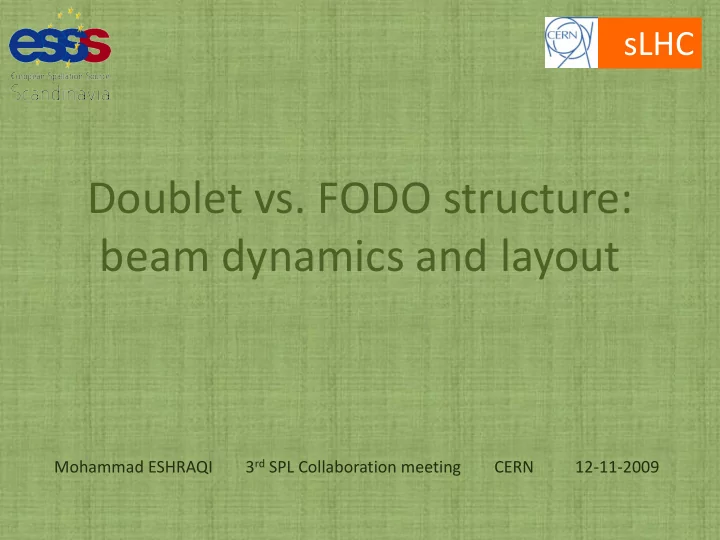

sLHC Doublet vs. FODO structure: beam dynamics and layout Mohammad ESHRAQI 3 rd SPL Collaboration meeting CERN 12-11-2009
sLHC SPL layout Source LEBT RFQ MEBT DTL CCDTL PIMS HEBT Low β High β 3 MeV 50 100 160 165 5000 Source: 70 mA of H - ions at 45 keV RFQ: 60 mA, 352.2 MHz DTL: Three tanks (FFDD+FD) CCDTL: 7 Tanks (FD) PIMS: 12+1 Tanks (FD) Elliptical: Two generations of elliptical cavities, geometric betas of 0.65 and 1. (Doublets , or singlets) 704.4MHz 12-Nov-09 M. Eshraqi, 3rd SPL collaboration meeting 2
sLHC SPL layout 10 × Low β 5 × High β 6 × High β 12 × High β Extraction Extraction Doublet, baseline, design: 10 low beta cryo-modules (Transition Energy 780 MeV) 5 high beta cryo-modules (Extraction Energy 1516 MeV) Extraction to ISOLDE 6 high beta cryo-modules (Extraction Energy 2586 MeV) Extraction to EURISOL 12 high beta cryo-modules (Final Energy 4989 MeV) 12-Nov-09 M. Eshraqi, 3rd SPL collaboration meeting 3
sLHC Doublet (Baseline) Cryo-modules Low beta elliptical 12.3 m Quad length 450 mm Quad Aperture 100 mm High beta elliptical 15.1 m A black outline indicates the Doublet (baseline) from now on 12-Nov-09 M. Eshraqi, 3rd SPL collaboration meeting 4
sLHC FoDo Cryo-modules Low beta elliptical 14.8 m High beta elliptical 15.1 m 12-Nov-09 M. Eshraqi, 3rd SPL collaboration meeting 5
sLHC Comparison L (m) E (MeV) Periods Cav/period Total Cav/ Quad (PS) 244 / 86+4 warm (54) Doublets 501 786 / 4989 20 / 23 3 / 8 240 / 96 + 4 warm (59) FoDo 510 710 / 5020 24 / 24 2 / 8 The gradient of the quadrupoles vs. length in two layouts Doublets FoDo Warm-Cold transition quadrupoles 12-Nov-09 M. Eshraqi, 3rd SPL collaboration meeting 6
sLHC Beam dynamics - Design X Synchronous phase ramps up from Y -19 to -14 in β g = 0.65 and stays at -14 except in the extraction regions Z Doublet layout FoDo layout X Y Z 12-Nov-09 M. Eshraqi, 3rd SPL collaboration meeting 7
sLHC Beam dynamics - I RMS beam envelopes for a beam generated at PIMS input for the Doublet option RMS beam envelopes for a beam generated at PIMS input for the FoDo (Singlet) option 12-Nov-09 M. Eshraqi, 3rd SPL collaboration meeting 8
sLHC Beam dynamics - II 12 Beam energy along the machine, in the 6 doublet layout, 5 1516, 2586. 13 Beam energy along the machine, in the 5 FoDo layout, 6 1542, 2491, 12-Nov-09 M. Eshraqi, 3rd SPL collaboration meeting 9
sLHC Beam dynamics - III X Y Z Doublet x y z FoDo x y z Initial ε Initial ε 0.328 0.334 0.468 0.328 0.334 0.468 Final ε Final ε 0.369 0.365 0.486 0.359 0.356 0.546 Δε % Δε % 12.5 9.4 3.8 9.5 6.5 16.6 12-Nov-09 M. Eshraqi, 3rd SPL collaboration meeting 10
sLHC Er ρ ør Studies ±0.2mm (Gaussian), Without Correction With Correction ±0.5%Grad on Quads ±0.3mm, 0.3mrad Doublet FoDo Doublet FoDo (Uniform) on input beam Δε x / ε x (Ave ± 3 × σ ) 14.77% ± 18.29% 10.51% ± 14.85% 1.05% ± 2.99% 0.44% ± 3.6% Δε y / ε y (Ave ± 3 × σ ) 12.64% ± 17.09% 13.91% ± 15.97% 0.55% ± 2.41% 0.76% ± 1.89% Δε z / ε z (Ave ± 3 × σ ) 25.49% ± 30.1% 23.62% ± 20.68% 1.2% ± 4.66% 0.77% ± 3.74% Transmission 100% ± 0.02% 100% ± 0.00% 100% ± 0.00% 100% ± 0.00% Doublet FoDo Piero will give a comprehensive talk on this subject in “3rd combined session WG3 & WG4” 12-Nov-09 M. Eshraqi, 3rd SPL collaboration meeting 11
sLHC Conclusion A FoDo architecture (in contrary to a doublet architecture) has been designed and studied, this FoDo layout has some pros and cons as listed: Pros: Number of low beta cavities reduces by 12 Quadrupole fields are reduced by a factor of ~2 Cons: 8 more quadrupoles are needed in low beta region In high beta region one more cryo-module (2 Quads + 8 cavities) is needed Less flexible for cryo distribution Nominal beam dynamics results of the FoDo and doublet are comparable, but error studies favor the FoDo option 12-Nov-09 M. Eshraqi, 3rd SPL collaboration meeting 12
Recommend
More recommend